In the fast-paced world of web technology, performance is king. One critical aspect of ensuring a smooth, efficient user experience is managing server resources effectively. For websites running on Apache, one of the most popular web servers, this often involves limiting bandwidth and the number of connections. This article will guide you through the steps for optimizing web performance by controlling these parameters on both Red Hat Enterprise Linux (RHEL) and Debian-based systems.
Understanding the Need
Before diving into the technical details, it’s essential to understand why limiting bandwidth and connections is crucial. Bandwidth caps can prevent a single user or service from monopolizing the server’s network resources, ensuring fair resource distribution. Similarly, limiting connections can help in avoiding server overloads, especially during traffic spikes, which can lead to slower response times or server crashes.
Available Tools and Modules
Apache provides several modules for controlling bandwidth and connection limits:
- mod_bw: This module allows administrators to limit bandwidth usage per virtual host or directory.
- mod_reqtimeout: Helps in managing connection timeouts, reducing the risk of Slowloris attacks.
- mod_cband: Another useful module for bandwidth throttling and monitoring.
Ensure that these modules are installed and enabled on your server. The availability and names of these modules may vary slightly depending on your system’s version.
Installation and Configuration
Step 1: Installing Apache
Use one of the following command as per your operating system to install Apache web server:
- On RHEL/CentOS:
sudo yum install httpd - On Debian/Ubuntu:
sudo apt-get install apache2
Step 2: Enabling Modules
Then enable Apache modules:
- On RHEL/CentOS:
sudo yum install mod_bwsudo httpd -M | grep bw_module - On Debian/Ubuntu:
sudo apt-get install libapache2-mod-bwsudo a2enmod bwsudo systemctl restart apache2
Step 3: Configuring Bandwidth Limits
Edit the Apache configuration file (httpd.conf or apache2.conf depending on your distribution) to set up bandwidth limits. You can limit bandwidth globally or for specific directories.
Example Configuration:
<IfModule mod_bw.c>
BandWidthModule On
BandWidth all 512000
MaxConnection all 100
</IfModule>
This configuration enables the bandwidth module, sets a global limit of 512 KB/s, and restricts the maximum number of connections to 100.
Step 4: Configuring Connection Limits
Use the mod_reqtimeout module to configure connection timeouts. This can be done by editing the same Apache configuration file.
Example Configuration:
<fModule mod_reqtimeout.c>
RequestReadTimeout header=20-40,MinRate=500 body=20,MinRate=500
</IfModule>
This setup configures the server to wait for a complete request header and body within specified time limits and rates.
Testing and Monitoring
After configuring Apache, restart the server:
- On RHEL/CentOS:
sudo systemctl restart httpd - On Debian/Ubuntu:
sudo systemctl restart apache2
Ensure to test your website’s performance and monitor server logs to verify that the new settings are effectively managing the load. Tools like Apache’s ab (Apache Bench) or online services like GTmetrix can be used for performance testing.
Conclusion
Optimizing web performance by limiting bandwidth and connections in Apache is a vital step towards maintaining a robust, efficient website. While the configurations mentioned are a starting point, remember that each website has unique needs. Regular monitoring and adjustments are key to finding the perfect balance for your server’s performance and resource allocation.
Always back up your configuration files before making changes and consult Apache’s official documentation for the most recent and detailed information regarding module configurations and capabilities.


2 Comments
Hi,
I have a question here.
From several sources on the Internet, they said that theses commands:
BandWidth all 1000
MaxConnection all 10
will limit max bandwidth usage and number of connections to the our server/ VPS as a whole (not specifically to any 1 user’s IP address), but from other sources people said these lines would limit bandwidth usage and connections based on each user’s IP address. Which is true?
For my purpose, I want to limit the bandwidth usage and max connections EACH USER can consume at the same time from my site (because I’m opening a file sharing service and I don’t want some user to open like 10 downloads simultaneously). I certainly don’t want to limit the max number of connections of ALL USERS TO MY SERVER, because there might be cases that more than 100 or 1000 users accessing my site at the same time – and that’s fine.
Any thought?
Thanks,
Jeff.
Thank you for sharing this info…I tried this on my server and its working fine 🙂